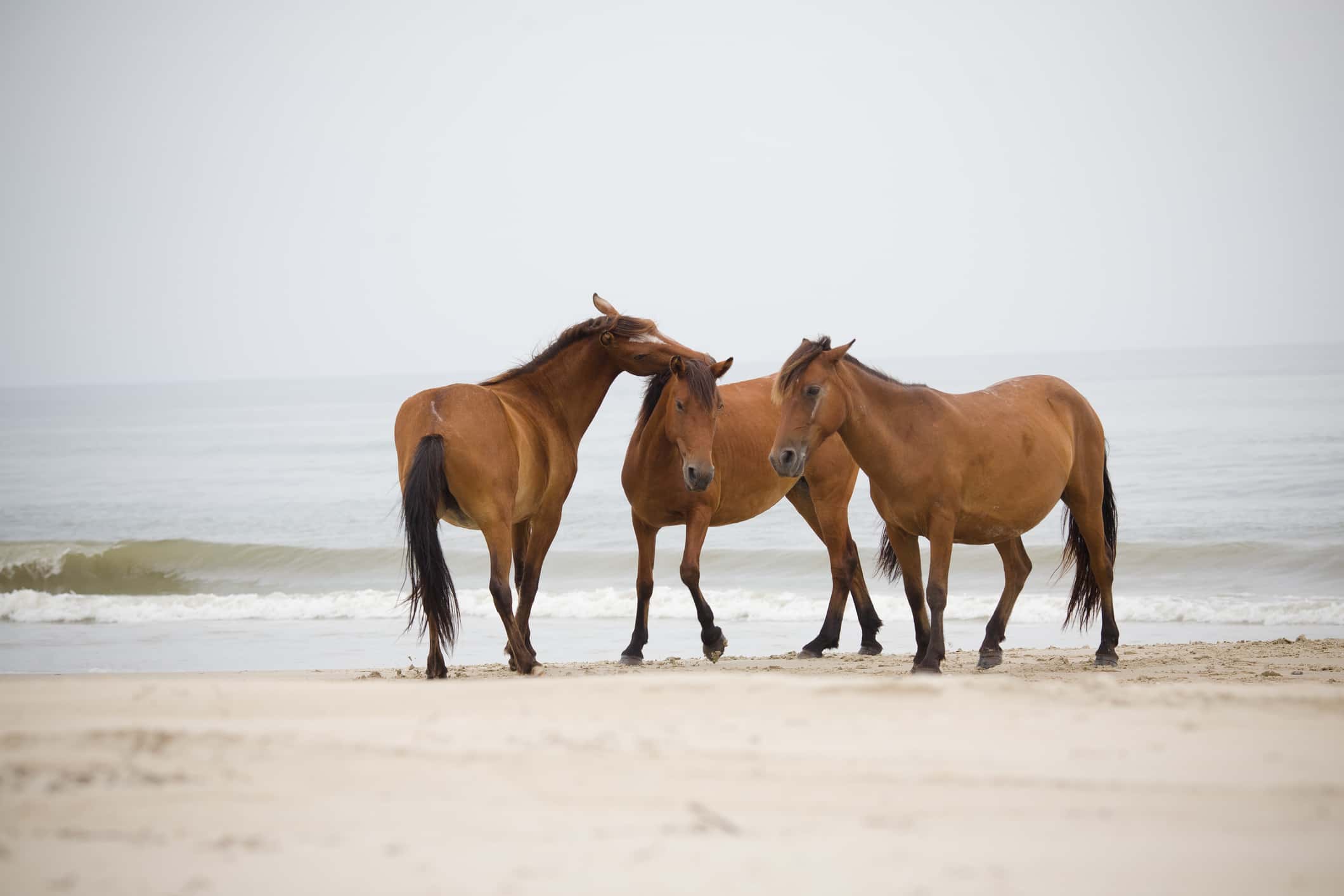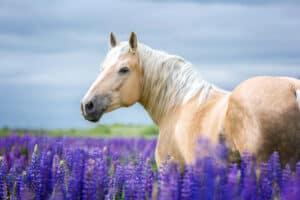Many people know that Mustangs roam freely in the Western United States, but did you know there are places to see wild horses on the East Coast too? It’s not uncommon to catch a glimpse of wild horses across Maryland, Virginia, North Carolina, and Georgia if you’re in the right spot.
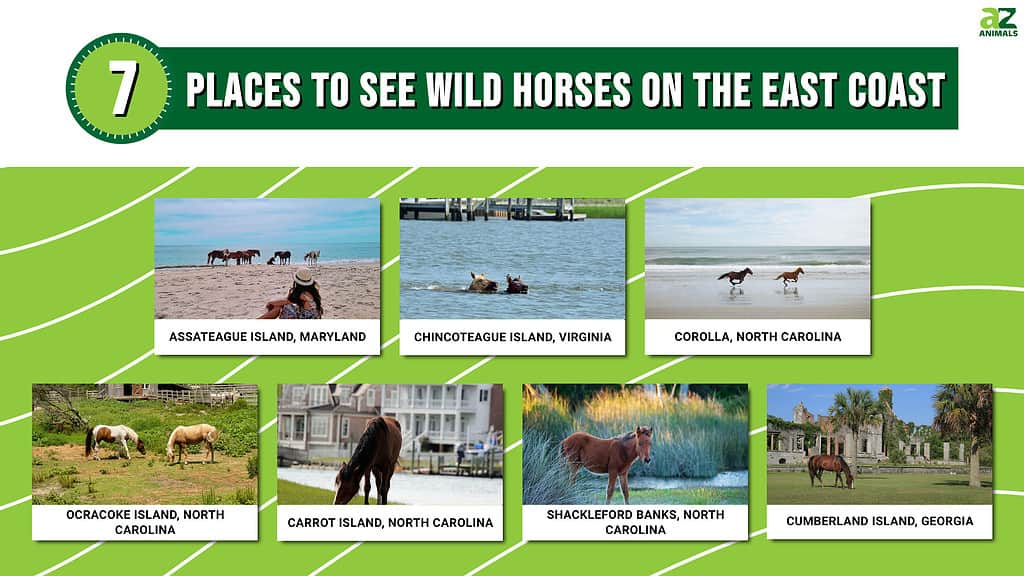
Ready to discover where the East Coast’s wild horses reside? First, let’s visit a popular vacation destination where it’s common to see these majestic animals in the flesh.
Are There Wild Horses in the Outer Banks?

It’s true! You can spot wild horses along the islands of the Outer Banks.
The Outer Banks, famously known as OBX, is renowned for its tourism industry which draws over 5 million visitors to the islands each year. Its quaint, laid-back town offers excellent shopping experiences, breathtaking beaches, delicious dining options, and wild horses to wander about.
Wait… wild horses in OBX? It’s true!
Mustangs brought to the Americas by the Spanish Conquistadors over 500 years ago still live on the islands, drawing in horse-loving tourists every year. Where else can you see wild horses on the East Coast? There’s one particular ecosystem they seem to gravitate to: islands with beaches.
East Coast Beaches With Wild Horses
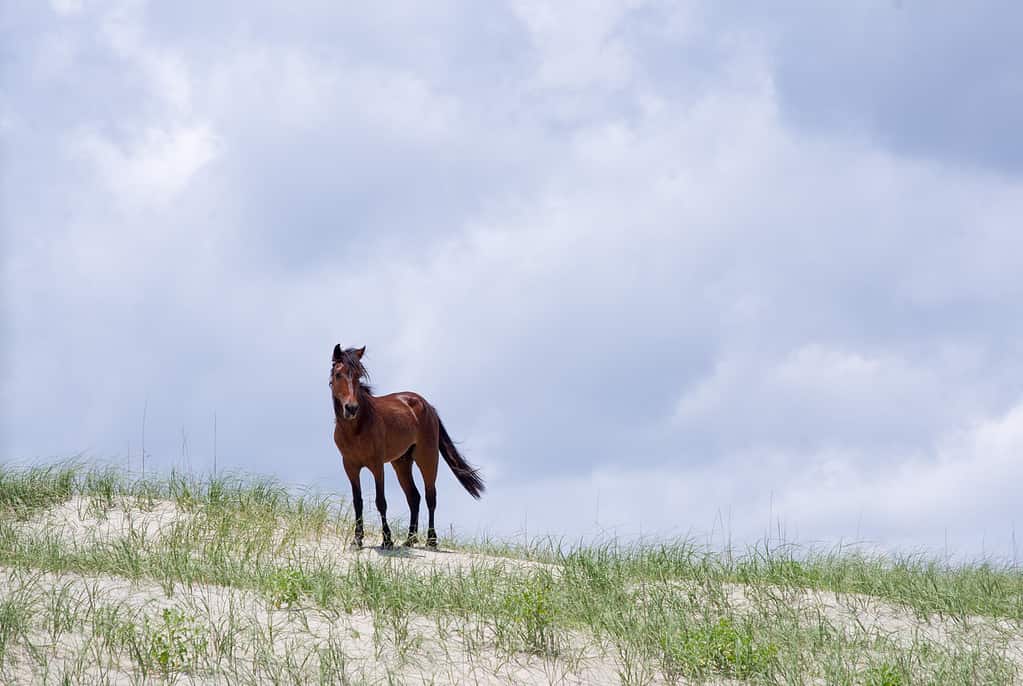
The wild Spanish Mustang is the state horse of North Carolina.
©BHamms/Shutterstock.com
Wild horses on the East Coast tend to live along the coastal beaches, wandering around nearby forests and marsh areas in search of forage.
East Coast beaches are an especially popular vacation spot for burned-out workers looking for a quick getaway. Access to the ocean, immersion in nature among stunning scenery, and a diverse array of wildlife and fauna — including wild horses — bring visitors back year after year. But where specifically do people go to see wild horses on the East Coast? Let’s discuss our top recommendations.
7 Places to See Wild Horses on the East Coast
You can find wild horses living in Maryland, Virginia, North Carolina, and Georgia. But they aren’t just anywhere in those states! Here are seven specific locations where you’re sure to spot a Mustang in the wild.
1. Assateague Island, Maryland
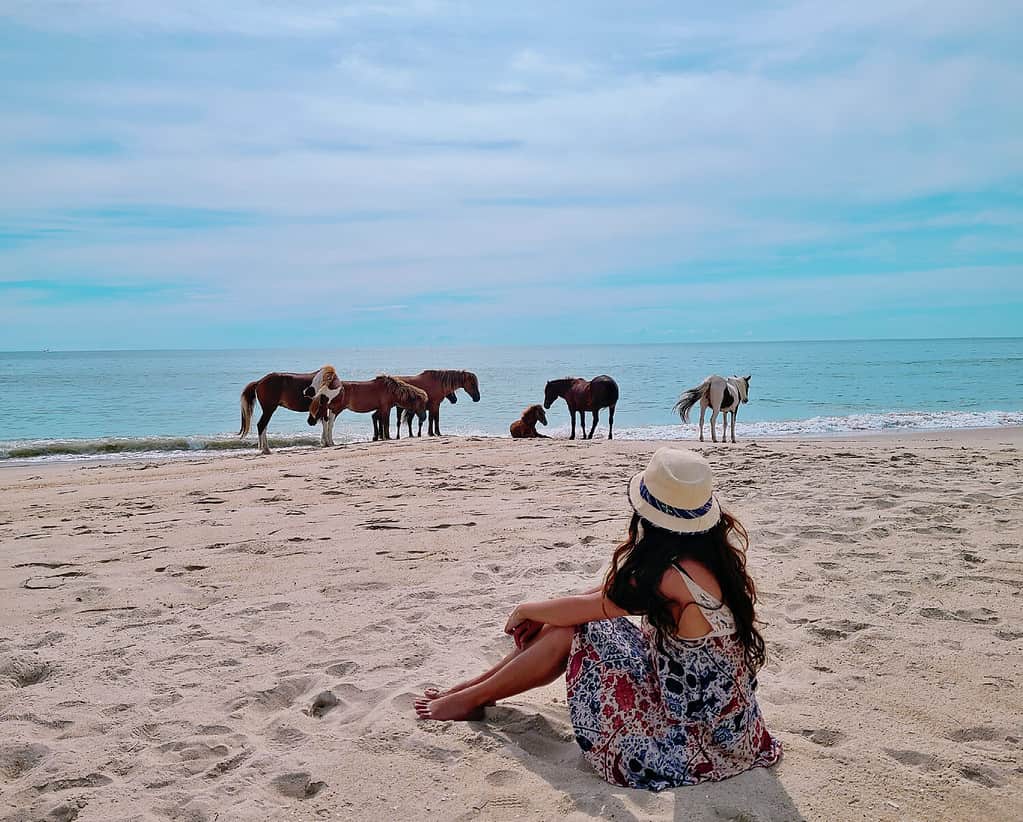
Maryland is home to wild horse herds who live on Assateague Island.
©Vicky Faye Aquino/Shutterstock.com
The Northernmost state on the East Coast where it’s common to see wild horses is Maryland. Specifically, on Assateague Island.
The herds of wild horses on this island are feral and free to roam, living completely off the land. The National Park Service manages the horses, carefully tracking their population numbers. As of March 2023, 29 stallions and 46 mares — 75 horses in total — are living on Assateague Island.
You can spot them grazing among the beachgrass, trotting along the coastline, or wandering across other remote areas of the island. Be sure to admire them from a distance of about 40 feet or more, though!
Since these wild horses roam freely, there’s no guarantee you’ll see them during your visit. If you want a 100% chance of spotting them, consider a trek down south to Virginia on Chincoteague Island.
2. Chincoteague Island, Virginia
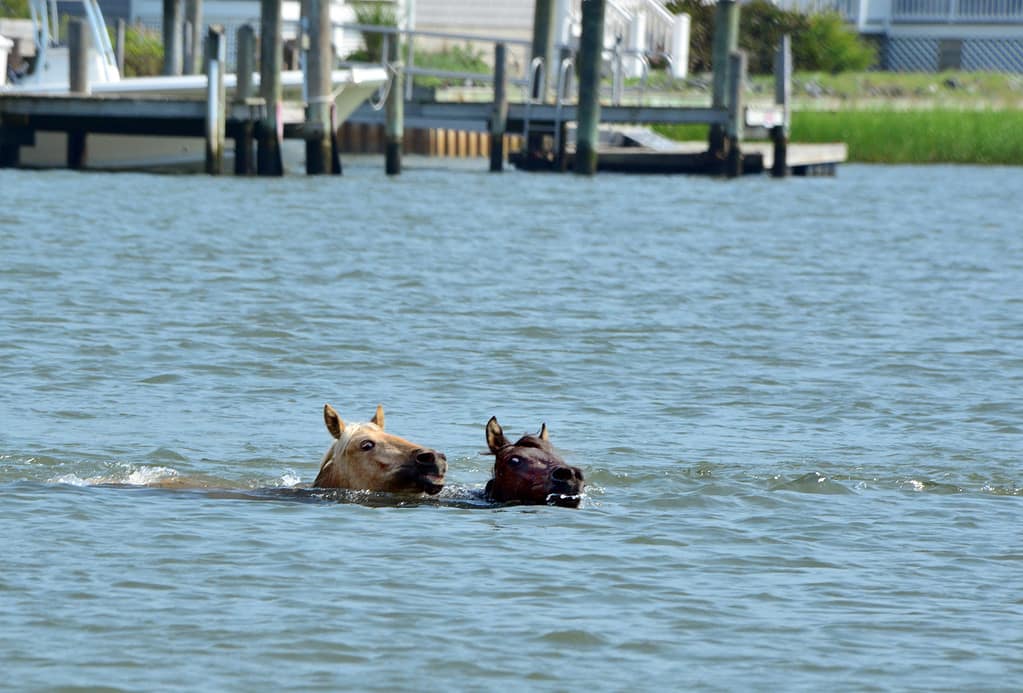
Wild horses swim across the channel in an annual event known as the Chincoteague Pony Swim on Chincoteague Island, Virginia.
©Edward Palm/iStock via Getty Images
You’re more likely to spot wild horses on Chincoteague Island in Virginia for two reasons: more horses live here than on Assateague Island — about 150 vs. 75, respectively — and they are contained within two fenced-in areas of the island managed by the Chincoteague Volunteer Fire Company.
The southern herd is easily visible to visitors of the island on foot, on a bike, or from a car. Beach Road provides lookout points over their grazing area and marsh, while the Woodland Trail hike allows you viewing access to the horses as well. These are the most recommended ways to see wild horses on Chincoteague Island because the northern herd is much harder to access.
Visitors who want to see the northern herd should expect a 17-mile round-trip hike to see these wild ponies due to their remote location on the island. To get a good look at them, you need to hike or bike Wildlife Loop, walk down the gravel service road, and be patient. The horses are visible after about 2.5 miles!
The other way to see wild horses on Chincoteague Island is during the annual Chincoteague Pony Swim in July. “Saltwater cowboys” swim the horses from Assateague Island across the channel to the eastern shores of Chincoteague Island. You can watch this unique, historical event from Veterans Memorial Park on Chincoteague Island.
3. Corolla, North Carolina
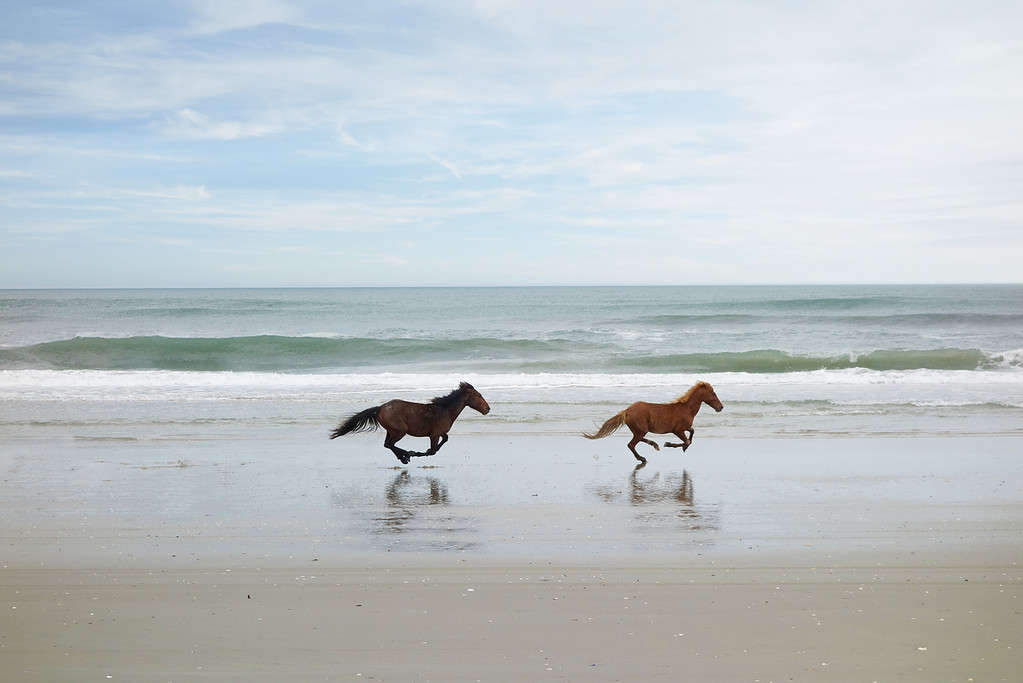
If you want to spot a wild horse along the beach, visit Corolla, NC.
©zimmytws/iStock via Getty Images
The Spanish Mustangs living in Maryland and Virginia are also found on North Carolina beaches.
One of the more popular places to spot a wild horse in North Carolina is in Corolla. Part of the Outer Banks, the wild horses roam freely here. However, they are most commonly found on the beaches only accessible by 4x4s.
If you don’t have a vehicle to bring you to these remote spots, consider booking a tour that will take you to see the wild horses. If you do have a capable vehicle, you can drive on the beaches to spot the horses, but be aware of restricted areas within the Corolla Wild Horse preservation area.
4. Ocracoke Island, North Carolina
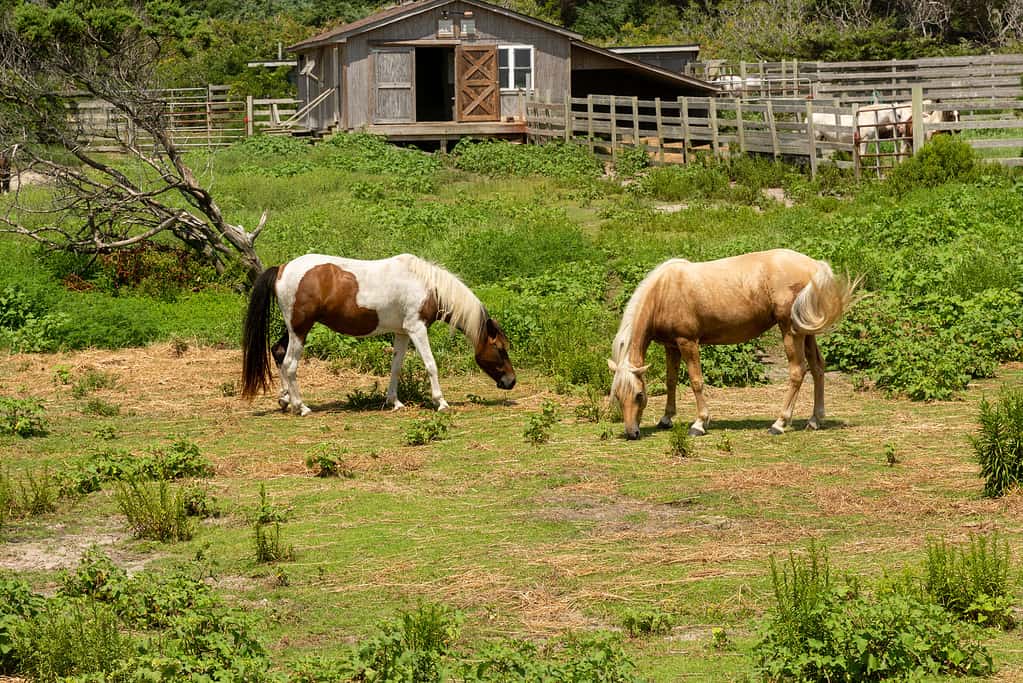
You can see the Ocracoke Banker Ponies at the Ocracoke Pony Pen off Highway 12.
©Liz Albro Photography/iStock via Getty Images
Another North Carolina island to find wild horses is Ocracoke. Since the 1960s, the herds here have been managed by the National Park Service.
The horses on Ocracoke Island are Banker Ponies. You can easily spot them by visiting the NPS Pony Pen, located south of the Hatteras ferry terminal. While they are not contained here 24/7, you have a better chance of seeing them here than in other more remote places.
As of October 31, 2023, conservation scientists are in the process of finalizing a report on the history, population, and impact of the wild horses on Ocracoke Island. We’ll know more about them from this research soon.
5. Carrot Island, North Carolina
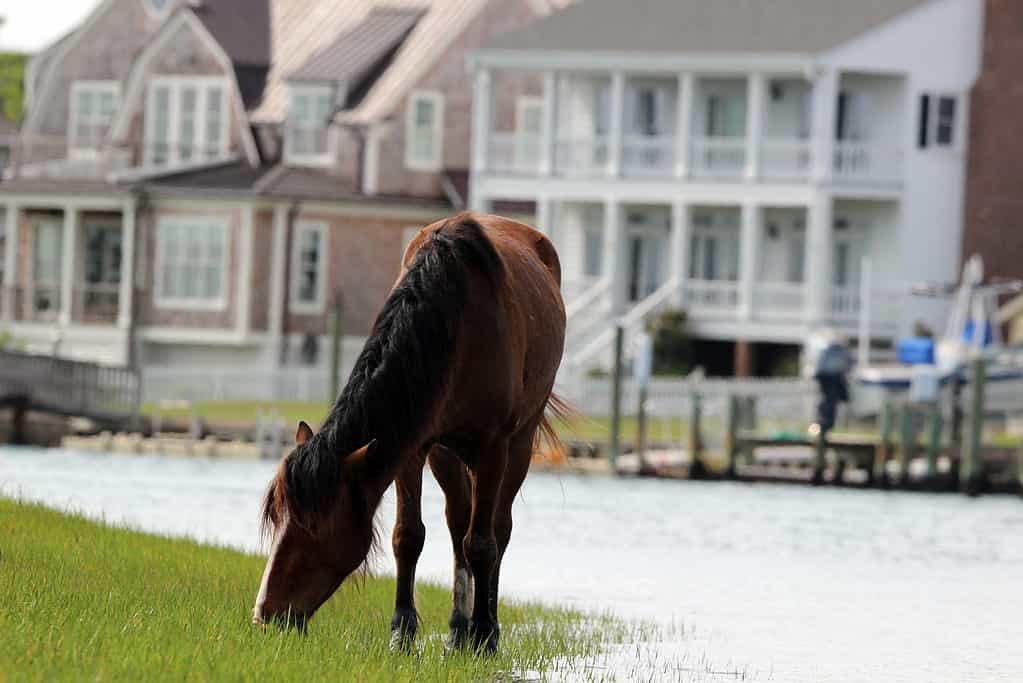
It’s common to see wild horses on Carrot Island, which is a part of the Rachel Carson Preserve in North Carolina.
©PamSchodt/iStock via Getty Images
North Carolina is home to many wild horse herds. This includes the wild horses roaming Carrot Island, which is a part of the Rachel Carson Reserve.
You can visit the roughly 40 horses that live on Carrot Island by boat or ferry. These wild horses are managed by the North Carolina Division of Coastal Management’s Coastal Reserve. A 1.1-mile trail within the Rachel Carson Reserve is the best spot to catch a glimpse of the horses that roam wild here.
Unlike the more northern states where descendants from Spanish Mustangs now reside, the herds here come from domestic stock kept on the island in the 1940s. The horses on Carrot Island are known as Banker Ponies and come from Quarter Horse bloodlines.
6. Shackleford Banks, North Carolina
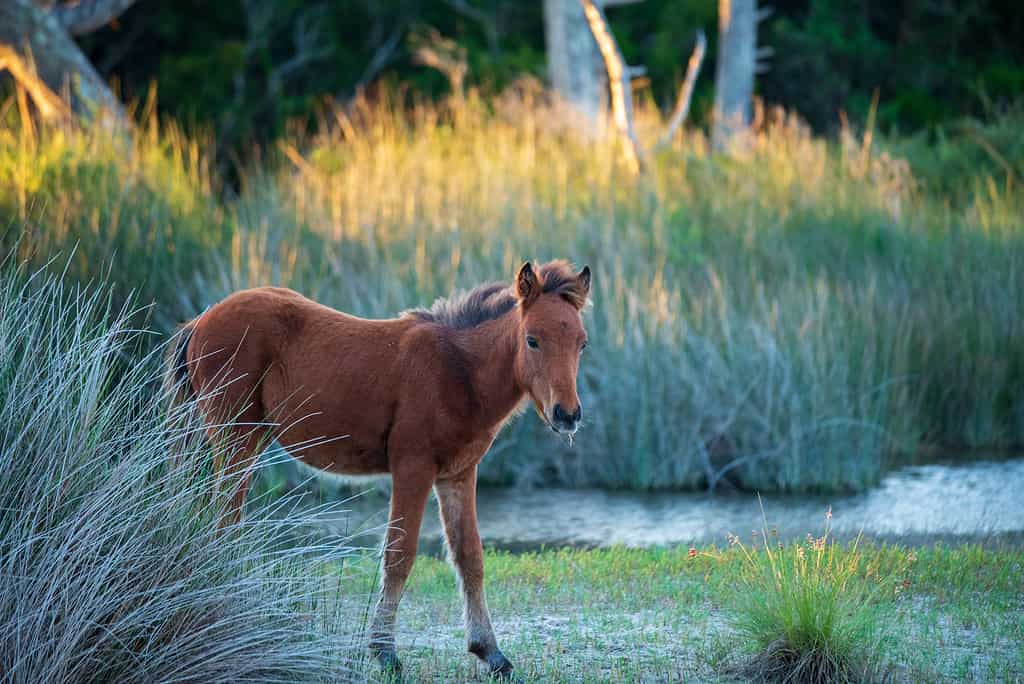
Over 100 wild horses reside in Shackleford Banks on the East Coast of North Carolina.
©Penny Britt/iStock via Getty Images
Further south in North Carolina, you’ll find another popular place to see wild horses on the East Coast. Over 100 wild horses live in Shackleford Banks, the southernmost island in the Cape Lookout National Seashore. You can always hike around the island until you find hoofprints or manure piles to track but, unlike other places we’ve discussed, you might need to take a boat or ferry to see the herds here.
7. Cumberland Island, Georgia

You can spot wild horses grazing at Dungeness Ruins on Cumberland Island National Seashore in Georgia.
©StockStudios/ via Getty Images
Between 150-200 horses roam wild in Georgia on Cumberland Island. These horses are the only unmanaged wild horses on the East Coast. Interestingly, genetic studies done on these horses point to Tennessee Walking Horse, American Quarter Horse, Arabian, and Paso Fino bloodlines.
If you want a chance to spot these truly wild animals, you can find them roaming the maritime forests and beaches of Cumberland Island National Seashore. A ferry gets you to the island, then it’s up to you to find them!
Summary of the 7 Places to See Wild Horses on the East Coast
There are numerous spots to see wild horses in their natural habitat out West, but not as many on the East Coast. However, they do exist here! This is your recap of the best places to see wild horses on the East Coast beginning up North and traveling South.
| Rank | Place |
|---|---|
| #1 | Assateague Island, MD |
| #2 | Chincoteague Island, VA |
| #3 | Corolla, NC |
| #4 | Ocracoke Island, NC |
| #5 | Carrot Island, NC |
| #6 | Shackleford Banks, NC |
| #7 | Cumberland Island, GA |
Thank you for reading! Have some feedback for us? Contact the AZ Animals editorial team.

